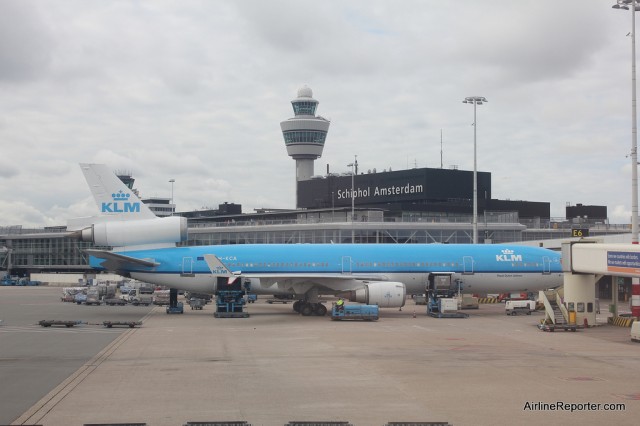
An MD-11 in KLM livery at Amsterdam (AMS).
This is a guest story by Drew Vane on the classic MD-11.
In July of this year, KLM started retiring their fleet of MD-11s with plans to replace them with more fuel efficient aircraft. “Phasing out the MD11 forms part of KLM’s ongoing fleet renewal programme,” a KLM spokesperson explained to AirlineReporter.com. “The last of KLM’s ten MD11s is expected to leave the fleet by the end of 2014.” For the long term, KLM plans to replace the MD-11s with 787-9s, but until then, they will Boeing 777s and Airbus A330s.
In my last article, I highlighted the DC-9 and its impending departure from the commercial skies. I’d thought its time was coming to a close, but Delta surprised me by extending the DC-9’s usage an additional year, but it looks like KLM won’t be delaying their MD-11 retirements.
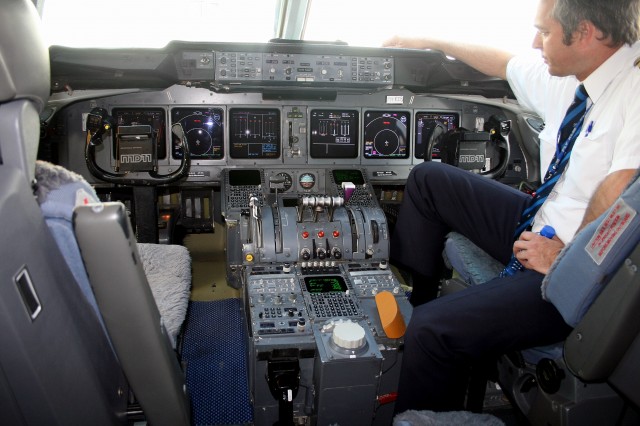
The flight deck of a KLM MD-11 (PH-KCB). Photo by Dave H.
Once KLM phases out the MD-11, there will be no other commercial airline flying this widebody tri-jet for scheduled passenger service. It’s anticipated that only few cargo and charter airlines will use the MD-11 in their fleet before disappearing from the sky forever.
The MD-11 came about when the aviation engineers at McDonnell Douglas decided an upgrade to the DC-10 was warranted. Instead of inventing a new aircraft, McDonnell Douglas took an already existing popular wide-body aircraft, whose biggest user and launch customer was American Airlines, and made it better.
The DC-10 was plagued with poor media attention due to some catastrophic failures in the 70’s and 80’s, including the worst commercial air disaster in US history, the loss of American Airlines Flight 191. With that flight, a DC-10 rolled over following takeoff and crashed in Chicago on May 25, 1979 which resulted in 270 deaths.
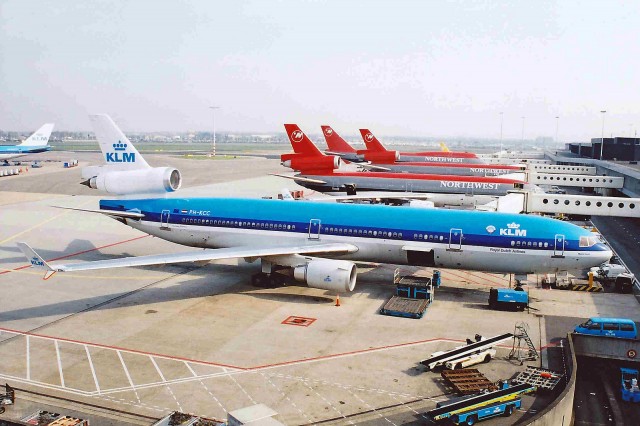
KLM MD-11 at AMS with Northwest DC-10s in the background. Image taken in 2001 by Ken Fielding.
New technological advances had a major impact on what led to the DC-10 Super 60 project, what would eventually become the MD-11. Boeing’s website best describes what exactly made the MD-11 better than its predecessor. Specifically it states that the MD-11 has ’œadvances in aerodynamics, propulsion, aircraft systems, cockpit avionics and interior design.’ What does all the mean? Well, a leaner and meaner version of the DC-10. Here is a summary of the modifications:
- Advanced Cockpit: Fly-by-wire technology, CRT displays, dual flight management system computer (eliminates need for a flight engineer), hydraulic fuses to prevent loss of control in catastrophic conditions, central fault display system, GPS, and Cat III automatic landing capability for extremely bad weather.
- Composite Materials: Usage of light weight composites reduced overall weight and allowed for a fuselage 40 feet longer than the DC-10.
- Aerodynamic design: Added winglets produce 2.5% more efficiency in drag as well as wing and tail improvements.
- More efficient engines: More efficient aircraft engines were developed by Pratt & Whitney, GE and Rolls Royce. New engine types resulted in greater thrust as less fuel usage and longer range.
The table below highlights how these improvements directly related to a longer range and more efficient aircraft. To make things apples to apples, I’ve chosen versions that were the best of each aircraft type.
|
DC-10-30
|
MD-11 ER
|
| Cockpit Crew |
3
|
2
|
| Passengers (3-class) |
255
|
293
|
| Passengers (2-class) |
285
|
323
|
| Maximum Range (full load) |
6,600 mi
|
7,240 mi
|
| Maximum Cruise Speed |
Mach 0.88
|
Mach 0.88
|
| Maximum Takeoff Weight |
572,000 lbs
|
630,500 lbs
|
| Maximum Fuel |
36,650 gallons
|
38, 615 gallons
|
| Engines – Thrust |
PW4462 – 62,000 lbf
|
PW JT9D-59A – 53,000 lbf
|
| Fuselage Length |
170 ft
|
192 ft
|
| Wingspan |
165 ft
|
169 ft
|
So, what we have is a longer range aircraft that is capable of carrying more passengers with less crew and a state-of-the-art cockpit.
If you want to catch a ride on one of these ’œMighty Dogs’ after KLM retires their 9 remaining aircraft, short of buying your own, you’ll have to fly on a charter flight or ship yourself via Fedex, UPS, Eva Cargo or Lufthansa Cargo.
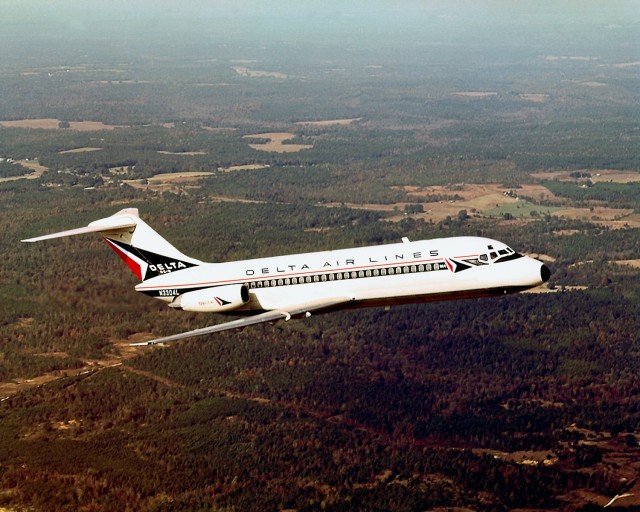
DC-9 “Delta Prince” in flight over wooded area, taken in the 1960’s. Image courtesy of Delta Air Lines.
This Story was Written by Andrew Vane for AirlineReporter.com:
Last summer I had the pleasure of writing an aircraft highlight article on the Mad Dogs and their history which began with the DC-9 and has brought us to the Boeing 717. About a year ago, Delta Air Lines, one of the last US airlines still operating the DC-9’s, announced that they would be retiring the last remaining 35 DC-9-50’s over the next 12-18 months. As of September 2011 the number of DC9’s in use was down to about 27.
In Fall 2011, I realized that I had to plan a business trip to Nashville from Charlotte for a national conference related to my work. While air travel is not usually a part of my work, I really enjoy choosing flights based on aircraft within my travel window, not only for comfort but for the experience. What I realized for this trip is that the Charlotte to Atlanta flights and Atlanta to Nashville flights afforded a wide selection in aircraft type from the telephone booth sized CRJ’s to the A319 and MD-88’s. What’s this? There are DC-9’s on that route?
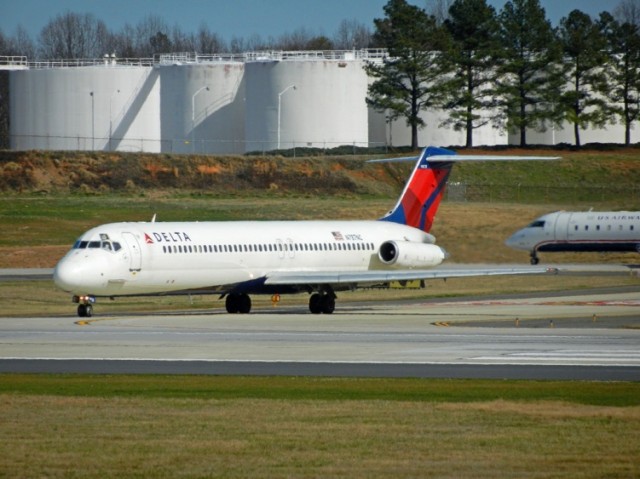
Delta DC-9 taxis onto Runway 18C at Charlotte, NC. Photo by Andrew Vane.
This means I have an opportunity to actually fly in what’s likely to be a museum piece in the near future. I suddenly realized I had to jump on this opportunity to ride this workhorse of the short range market before the opportunity is gone. As it turns out, I managed to book 3 of my 4 flight legs on the glorious DC-9-50. Only my Atlanta to Nashville flight would be on a different aircraft; the Airbus 319) The table below highlights the aircraft I was privileged to fly in for this trip:
| Flight Leg |
Aircraft Type |
Registration |
Year Built |
| Charlotte-Atlanta |
DC-9-50 |
N675MC |
1975 |
| Atlanta-Nashville |
Airbus A319 |
N302NB |
2000 |
| Nashville-Atlanta |
DC-9-50 |
N767NC |
1977 |
| Atlanta-Charlotte |
DC-9-50 |
N784NC |
1978 |
The DC-9 first entered service in 1965 with Delta as the launch customer. Delta eventually phased out the DC-9’s but reacquired them (along with Boeing 747’s and Airbus A319, A320 and A330’s) when it merged with Northwest Airlines in 2008.
I’ve been excited about this trip ever since I booked it last month with my company’s travel agent. If you’re looking for a luxurious flight experience, this aircraft is not the place to find it. Hopefully this article will contrast with the web site founder’s exotic meal laden VIP trips the rest of us common folk can only dream of taking. J My previous story on the Mad Dogs drew some comments regarding the smell of the lavatory wandering throughout the cabin. I sat right over the wing and couldn’t even smell a hint of the lavs. I could see every single rivet and bolt on the wing though.
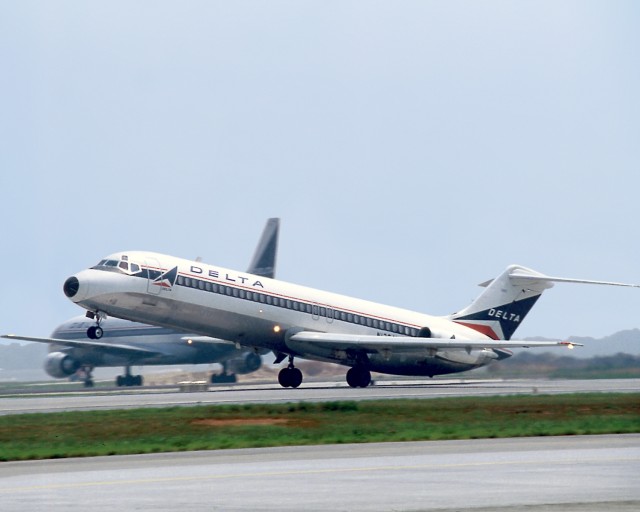
Delta DC-9 in updated livery. Check out the L1011 in the background. Image courtesy of Delta Air Lines.
As I strapped myself in, I couldn’t help but notice how modern the interior of Delta’s DC-9’s look. They’ve spared no expense in making you feel business as usual on all their aircraft, whether they’re 10 years old or 30. The captain came on and told us he was going to be starting the engines at the gate and that the lights would flicker a bit while he ran through some electrical checks. I almost expected to see some guy come out with a hand crank. I’m not sure if the gate startup is because they need ground power or for some other reason.
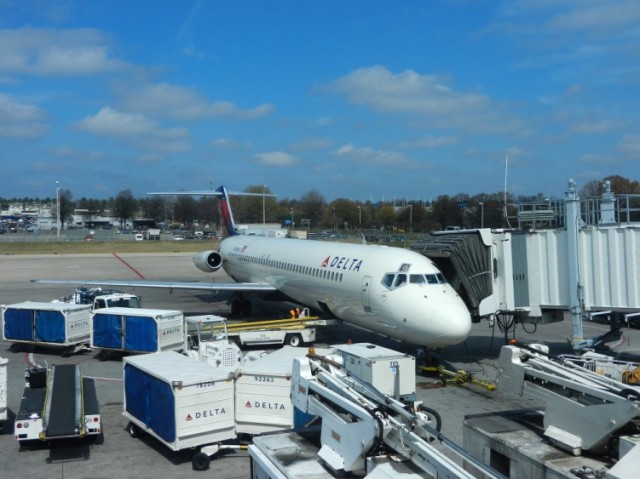
DC-9-50 at Delta’s gates in Charlotte, NC. Photo by Andrew Vane.
The DC-9 uses Pratt & Whiney JT8D turbojet engines with about 16,000 lbs of thrust each, the same type used by the 727, MD-88 and early versions of the 737. By contrast, the Airbus 319 uses European made CFM engines each are rated at 25,000 lbs of thrust each. I was thankful Charlotte has a 10,000 foot long runway because I figured we’d be needing all of it that day.
As expected, as we began our takeoff roll, I noticed it was taking quite a long time to get down the runway. It took a good 40 seconds to go from a rolling start to the hind wheels leaving the pavement. By comparison, the similarly sized A319 took 30 seconds to takeoff, but that was from a dead stop. The difference between engine thrust in the two aircraft was obvious. Still, the rumble in the DC-9 was definitely more fun an experience.
The flight went smoothly, the air conditioner worked, and we arrived right ’œon time,’ although I think the airline adds to the official travel time to allow for ground traffic and taxiing.
At the time of my travel in March, Hipmunk.com (an airline travel web site I frequent) showed Delta’s last DC-9 flights between Charlotte and Atlanta ending June 6th (being replaced with its longer MD88 cousin) and DC-9 flights from Atlanta to Memphis ending sometime in early October (being replaced with MD88’s and A319’s). However, one Delta pilot who took a lot of time after my first flight answering my questions told me Delta plans to fly DC-9’s at least for an additional year and plans a DC-9 ’œjet base’ for pilots in Atlanta. For now, I can postpone my farewell for at least another year or so.
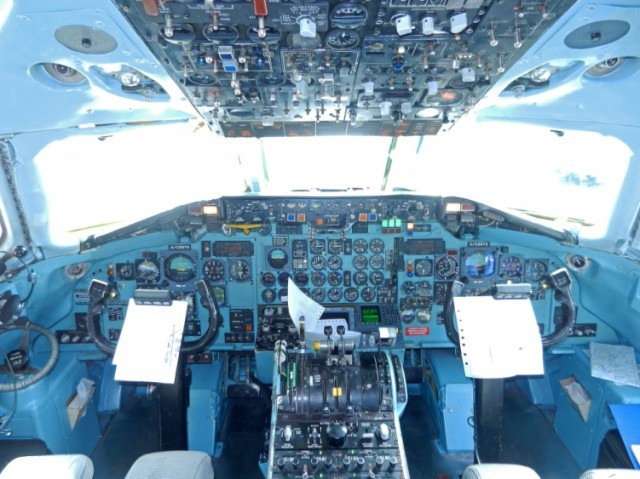
Teal Anyone? No FMC here. Its old school flying for sure.
Some of you fliers may enjoy the comfort and luxury of the newer aircraft. As I get older, I’m becoming more nostalgic and appreciating the older classics in life like a fine Merlot, Vivaldi and the DC-9.
I want to express my sincerest thanks to the Delta pilot Mark who took time to talk with me following each flight. My former landlord, a Delta 757 pilot, told me once after sitting in the jump seat of a DC-9 ’œBoy, those guys sure do work!’ Unlike the MD-80 series, the DC-9’s never received a cockpit upgrade. The pilots use nothing but the original steam gauges and fly VOR to VOR. While the newer aircraft with FMC’s let the aircraft fly the needle during cruise, the DC9 pilots often don’t know they’re off course until its too late. One pilot shared this with me and said he’d sometimes received ’œwhere are you going?’ questions from ATC after straying a bit off the route. ’œIf you’re within 4 miles you’re good,’ he told me.
This post is written by aviation and photography enthusiast Drew Vane about the MD-80:
Ahhh. I remember the good ole days when the aircraft were loud, smoked like a B-52 and fuel efficiency was unheard of. No, I’m not talking about the 60’s. I’m talking about yesterday.
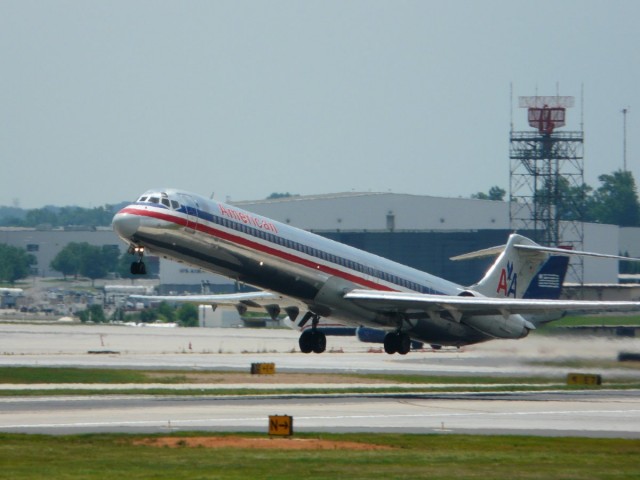
An American Airlines MD-83 (Super 80) lifts off of Runway 36C at Charlotte-Douglas International Airport.
As commercial aircraft manufacturers transitioned from props to jets, Douglas Aircraft Corporation developed a smaller jet aircraft for the shorter range domestic market. The 90seat DC-9 first flew in 1965 and gave birth to additional series, culminating with the 50-series under the original DC-9 design. McDonnell-Douglas introduced its newest, longer version of the DC-9, fondly called the DC-9 Super 80, or MD-80. This 142-seat product of Long Beach, CA got its start with PSA Airlines (eventually to become US Airways). The MD-80 added 15 feet in length and 20 feet in wingspan, resulting in an additional 28 seats to the 139-seat DC-9-50.
Similarly, the MD-80 family (also called the ’œMad Dogs’) has improved with each subsequent version. The MD-88 added aerodynamic improvements for longer range, a redesigned tail-cone, and glass cockpit. The MD-90 upgrade increased capacity to 150 passengers and replaced the Pratt & Whitney JT8D engines with quieter, more fuel efficient IAE V2500 engines. Following the merger of McDonnell-Douglas with Boeing in 1997, a further upgrade, the MD-95, was born which eventually became the 117 seat Boeing 717. The 717 added a more advanced cockpit, more efficient engines, fly-by wire controls, and other features to bring it into the 90’s and beyond. Strangely, the AFC (or Advanced Common Flightdeck) most closely resembles that of the massive MD-11. Over 2,400 DC-9 series aircraft have been produced over the last 40 years.
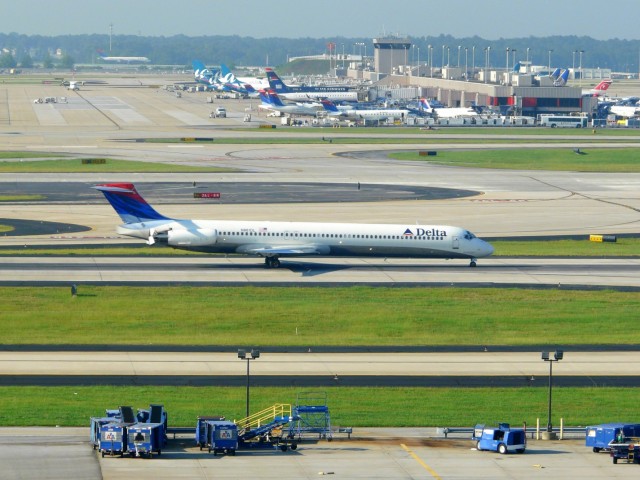
Look Ma! No Rabies! A Delta Air lines MD-88 slows after landing at Atlanta’s Hartsfield International Airport
Although the seating configuration is a bit skewed (2-3), today you’ll still find these workhorses on domestic routes for Delta, American and Allegiant here in the US. The Boeing 717 is flown in the US by AirTran (soon to be Southwest) and Hawaiian Airlines. As of midway through 2010, there were over 450 Mad Dogs still flying here in the US with 100 or so still active in other countries.
Its been a long time since my last Mad Dog flight but I was pleasantly surprised last November when I flew with my family on an AirTran Boeing 717 down to Florida. The holidays brought free WiFi and the aircraft just felt newer compared to my memories of the Mad Dogs. Here in Charlotte, there are ample opportunities to spot the Airtran 717’s and Delta MD-88’s bound for Atlanta as well as the fully loaded American Super-80 bound for Fort Worth that seems to use every inch of the runway on taking off.
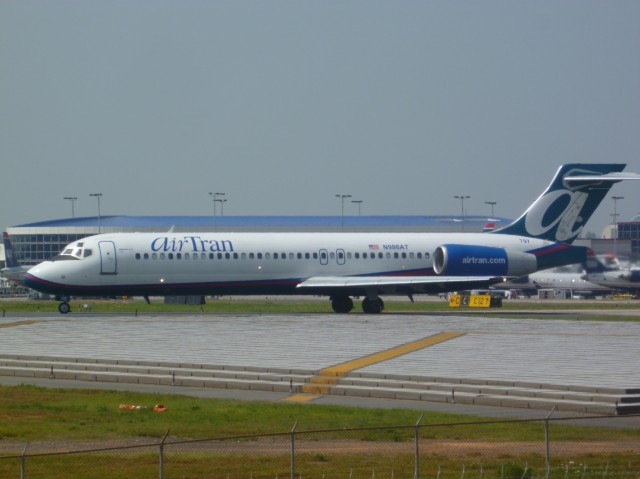
Mad Dog Wannabe: An AirTran Boeing 717 taxis onto Runway 18L at Charlotte Douglas International Airport.
Unfortunately, the sun is slowly setting on these older aircraft as more eco-friendly, and efficient domestic jets continue to enter the market. American recently announced its plan to replace its fleet of MD-83’s (in addition to its 757’s and 767’s) with re-engined Boeing 737 and Airbus A320neo jets and its expected that Delta will follow in its footsteps to stay competitive. Have you had the opportunity to ride on these gas guzzlers lately? I’d love to hear about your experience.
More info on the background of the MD-80 here and MD-90 here.
All photos by Andrew Vane










